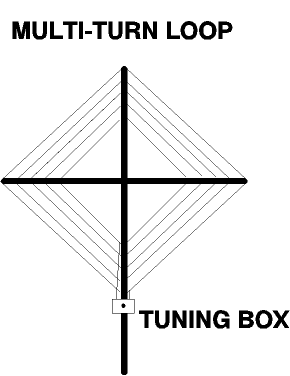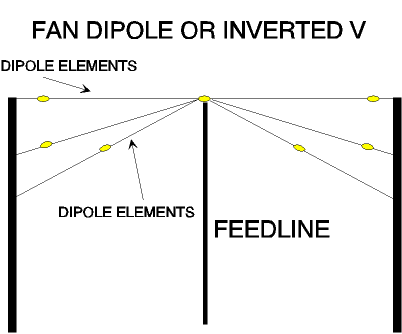Antennas for Shortwave Listening
There are many SWL’ers out there and judging by the numerous questions arriving at antenneX and there seems to be some confusion about what antenna(s) are best for SWL. The answer is simple. It’s whatever antenna can put up in the clear and as high as you can get it. Any antenna used for transmitting can be used for reception. The only difference is that the insulation requirements are reduced for reception only. Beams, long wires, inverted L antennas are among the most popular, with the HF beams being rarely used by SWLs. But before you proceed, make sure your receiver has the terminal connections for an external antenna, because if it doesn’t, you will have to do things a little differently.
If you do not have an external antenna connection, then the antenna will have to be connected to the radio’s whip antenna usually by wrapping the antenna lead in around the whip itself. Sometimes this results in the receiver overloading on strong signals. The way around this is to wrap the insulated wire around the whip instead of stripping the wire. This will give enough coupling to improve the reception without overloading the receiver. This tip comes from Radio Havana and the Dxer’s Unlimited program hosted by Arnie Coro, CO2KK. Arnie has a lot of information on his program and the schedule for his program is listed elsewhere in antenneX. It also helps to strip the insulated antenna wire and ground it after wrapping it around the whip several times. This completes the antenna circuit. Sometimes this helps reception and sometimes it does not, you just have to experiment. A good ground is also part of your antenna circuit and should be used at all times.
The frequency you want to listen to is another factor that determines what to use. If your only interest is the high frequency range between 1.6 and 30 MHz, then there are a some antennas that are better than others. Among them is the multi-turn loop, very good for the 2 to 6 MHz range. This antenna will allow you to null out interference sometimes and also peak up the incoming signal at times. It can be peaked up for a given frequency, which increases its ability for reception on a desired frequency. Usually they are rather small and can be placed inside a room with the receiver. This enables you to tune for maximum signal by watching the receiver S-meter. Above 6 MHz, the loop sometimes loses its effectiveness, depending on how it was built. There are commercial loops just for the SWL made by Palomar and others. But you can easily make one from wooden dowels, PVC, even tree branches or bamboo. The wire can be small diameter, as there is no transmitter involved. Figure 1 shows this type of loop antenna.

In some cases, there is no place to hang any kind of antenna except a small whip. In this sort of predicament, an active antenna will be what is required, if possible. An active antenna is one with a preamplifier built into a case, usually with a short whip mounted on it. It is designed to be placed outdoors away from the receiver. The power is supplied to the preamp via the feedline and in some cases, the preamp can be remote tuned. These antennas usually work very well, but can be damaged by static build up during electrical storms and in dry conditions. Fortunately, most of the manufacturers have taken this into consideration and put some sort of static drain in the preamp. It does not hurt to add a RF choke to ground if possible.
The other kind of preamp not designed for placement outdoors can be useful. But, the problem with this type of amplifier is that it amplifies the signals that can be picked up by the antenna line as well as what comes in from the antenna. So it can pick up the noises generated by anything electrical, such as motors, microwave ovens, and other noise generators. The antenna-mounted preamps are not as prone to this since the signals amplified from the antenna input are usually sent down coax cable. This shields the signal from the preamp from external undesired noises.
If you are fortunate to be able to put up a fairly long wire, then life will be easier. In my own case, when I put up a 30 ft. wire for my Uniden receiver, I ended up with it being overloaded by an AM broadcast station about 2.5 miles from my house. So I was forced to install an attenuator. This is not the case for most of us, but needs to be kept in mind when installing an external antenna.
Due to its construction, an inverted L antenna (see antenneX article) is a good compromise since it picks up both horizontally polarized and vertically polarized signals well. This is not bad because signals coming from DX locations can be either vertical or horizontal, or a combination of both. This is also true of the sloper antenna, another good antenna for SWL. There are multiband versions of the sloper sold by various concerns and have been written about in different publications.
The dipole antenna is also another antenna that has been around for years and is also available in the multiband configurations. Along this line, the inverted V antenna works well for SWL usage. By using an inverted V, the polarization of the incoming signal can be mixed and the antenna receives all polarizations well. By adding more antenna wires, each pair cut for a shortwave broadcast band, this antenna can be multibanded fairly easily. Each pair of wires needs to be fanned out somewhat to cut down on interaction between the separate elements. Figure 2 shows this type of construction.

Vertical antennas are used for SWL. But, the verticals are more prone to pick up atmospheric noise prevalent in the lower frequency ranges from 1.5 to 7 MHz. Verticals, installed properly are good though, and can pick up the DX signals well due to the lower angle of radiation and reception that characterizes a vertical on its resonant frequency. The vertical also can be put up in a limited space and multibanded by using a tuning network at its base. There are too many variations that can be made from the vertical to go into here. Radials or some other ground system must be used for maximum effectiveness. Several people have used the roof of a mobile home as a ground plane for a vertical with success. It just depends on what you have to work with.
Selecting the right SWL antenna can be as complicated as any other antenna in the world, or they can be simple, depending on what is available in your part of the world for frequency of choice.
Originally posted on the AntennaX Online Magazine by Richard Morrow, K5CNF
Last Updated : 6h March 2024
